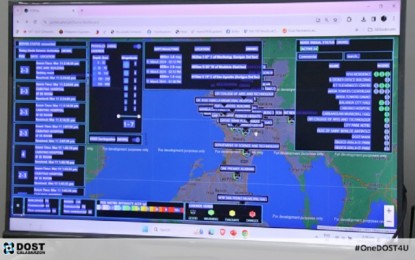
QUAKE TECHNOLOGY. A light-emitting diode (LED) screen displays how earthquakes affect the strength of buildings installed with the Universal Structural Health Evaluation and Recording (USHER) system in this undated photo. This system is currently installed at the San Pedro City Hall and Cabuyao City Hospital in Laguna province. (Photo courtesy of the Department of Science and Technology)
CALAMBA CITY, Laguna – Sophisticated equipment operated by the Department of Science and Technology (DOST) for monitoring the impact of earthquakes on infrastructure will remain installed in the San Pedro City Hall and Cabuyao City Hospital until September 2025.
An extension of the study on how seismic activity weakens certain buildings was made possible through a renewal of the agency’s agreement with the San Pedro and Cabuyao city governments, DOST 4-A (Calabarzon) announced Thursday.
In an interview, Harley Margallo, a spokesperson at DOST 4-A’s Public Affairs Relations and Communication Unit (PARCU), explained that the Universal Structural Health Evaluation and Recording (USHER) system apparatuses currently attached to the two structures are intended to detect infrastructure damage.
USHER technology was first installed in the two structures in 2022 when it was intended to be kept there for a one-year study.
“It is designed to monitor and assess the structural health of buildings, offers real-time insights into the integrity of structures, enhancing disaster resilience and promoting proactive maintenance,” she told the Philippine News Agency.
Margallo disclosed that Disaster Risk Reduction and Management Office (DRRMO) staff members from both cities recently underwent an orientation seminar on the operation of USHER Web Portal and the maintenance of USHER units installed in San Pedro City Hall, as well as in Cabuyao City Hospital.
“This is a significant step towards enhancing the disaster preparedness and response capabilities of the cities of Cabuyao and San Pedro, emphasizing the importance of collaboration and innovation in building resilient communities,” she said.
The USHER system is made up of an advanced accelerograph, a web portal, and a mobile application.
“The system allows the monitoring of any structure anywhere, at any time. It can be installed in all types of buildings and structures irrespective of their age, including bridges, and grants users, in particular developers and structural engineers, the ability to remotely monitor and analyze the host structure before, during, and after an earthquake,” according to the World Intellectual Property Organization.
The DOST is using USHER technology to remotely monitor the structural health of bridges and buildings, enabling officials to determine whether the structures need repairs or upgrades to withstand natural disasters.
“The system also enables stakeholders to comply with the codes set in the National Structural Code of the Philippines (NSCP) and the rules and regulations of the Department of Public Works and Highways’ (DPWH) Implementing Rules and Regulation on Earthquake Recording Instruments,” the DOST stated on its website.
“We have now the portal and mobile application for accessibility. During an earthquake, the devices will collect data consolidated to the USHER controller, then goes to the portal, generate alert data to short messaging system (SMS) and email for critical warning and alert status,” Margallo added. (PNA)
